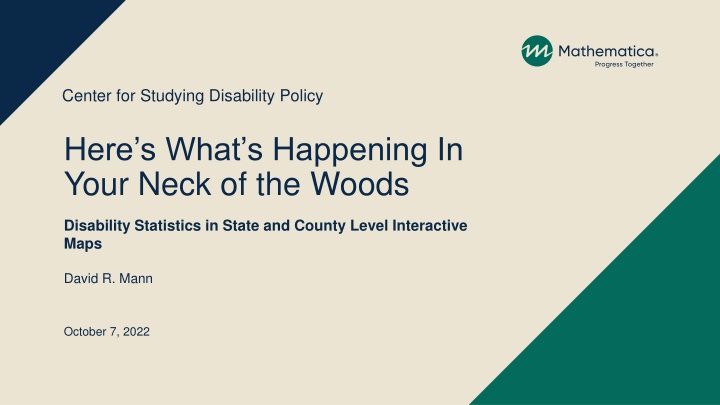
Interactive Disability Statistics Maps: Local Insights and Data Analysis
Explore interactive maps showcasing disability statistics at state and county levels, providing valuable insights for disability policy formulation and resource allocation. Discover data on disability prevalence, benefit receipt, minority youth, and more. These maps offer a comprehensive understanding of disability demographics in different regions, aiding in informed decision-making.
Download Presentation

Please find below an Image/Link to download the presentation.
The content on the website is provided AS IS for your information and personal use only. It may not be sold, licensed, or shared on other websites without obtaining consent from the author. If you encounter any issues during the download, it is possible that the publisher has removed the file from their server.
You are allowed to download the files provided on this website for personal or commercial use, subject to the condition that they are used lawfully. All files are the property of their respective owners.
The content on the website is provided AS IS for your information and personal use only. It may not be sold, licensed, or shared on other websites without obtaining consent from the author.
E N D
Presentation Transcript
Center for Studying Disability Policy Here s What s Happening In Your Neck of the Woods Disability Statistics in State and County Level Interactive Maps David R. Mann October 7, 2022
Local statistics are critical to informing disability policy, but they are not always available Having state and local disability data can be helpful - Understand geographic distribution of disability and related relationships - Suggests where and how to allocate scarce resources State and local/county statistics can be difficult to produce or present - Sometimes data do not have detailed local/county level data - There are many (i.e., 3,143) counties! Center for Studying Disability Policy 3
Mathematica has been creating interactive maps with disability statistics to address this need! Center for Studying Disability Policy
Interactive map on disability prevalence and SSA disability benefit receipt Using statistics generated by UNH, we created state and county maps for: - Disability prevalence - SSDI benefits - SSI payments How it works: - Select a series/outcome - Select a state - Move cursor over a county Can also download the data URL: https://www.mathematica.org/dataviz/state-disability-maps Center for Studying Disability Policy 5
An interactive map features state and county data on minority youth with disabilities Developed to help CILs understand local youth populations Data focuses on: - Youth ages 16-24 - Racial and ethnic minority status - Poverty - Education - Employment Funded by NIDILRR under the MYCIL DRRP URL: https://mathematica.org/dataviz/nonworking-osy- disability-maps Center for Studying Disability Policy 7
We just released a new interactive map on disability and natural disaster risk! Based on Harrarti et al. forthcoming State and county maps for: - Disability prevalence - Correlation between natural disaster risk and disability prevalence Can access analysis results/estimates for state and counties How it works: - Select a series/outcome - Select a state - Move cursor over a county URL: https://www.mathematica.org/dataviz/county-disability-natural- disasters-map Center for Studying Disability Policy 9
Please use these resources if helpful! We monitor use of these interactive maps Greater use of the existing maps encourages us to make more! We are also interested in your ideas about other maps to create Center for Studying Disability Policy 11
Other helpful StatsRRTC links UNH - Center for Research on Disability: https://www.researchondisability.org/ - Disability Compendium: https://disabilitycompendium.org/ Mathematica - Website: https://www.mathematica.org/ - StatsRRTC page: https://www.mathematica.org/projects/disability-statistics-and- measurement-rehabilitation-research-and-training-center-statsrrtc Center for Studying Disability Policy 12
Funding for this study was provided by the Research and Training Center on Disability Statistics and Demographics at the University of New Hampshire, which is funded by the National Institute for Disability, Independent Living, and Rehabilitation Research in the Administration for Community Living at the U.S. Department of Health and Human Services (DHHS) under cooperative agreement 9ORTGE0001. The contents do not necessarily represent the policy of DHHS, and the reader should not assume endorsement by the federal government (EDGAR, 75.620 (b)). Center for Studying Disability Policy 13
For more information David Mann DMann@Mathematica-mpr.com Twitter: @DavidRMann Center for Studying Disability Policy 14






















